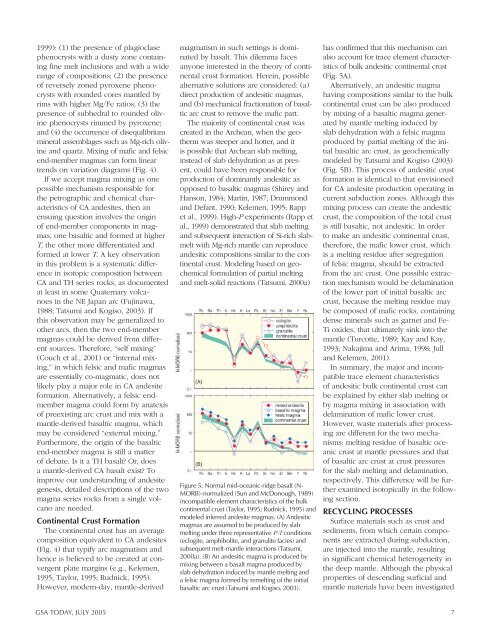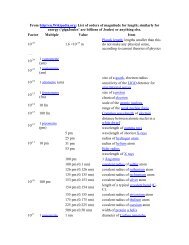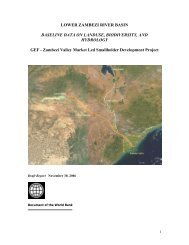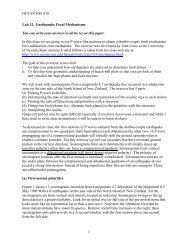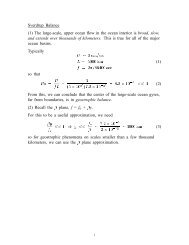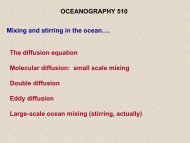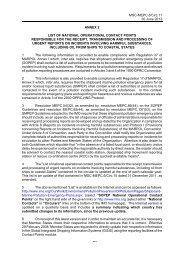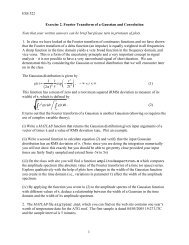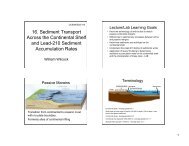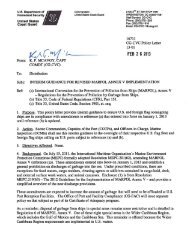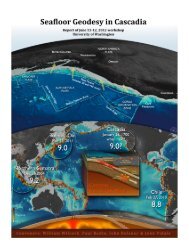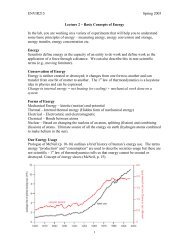The Subduction Factory - Geological Society of America
The Subduction Factory - Geological Society of America
The Subduction Factory - Geological Society of America
You also want an ePaper? Increase the reach of your titles
YUMPU automatically turns print PDFs into web optimized ePapers that Google loves.
1999): (1) the presence <strong>of</strong> plagioclase<br />
phenocrysts with a dusty zone containing<br />
fine melt inclusions and with a wide<br />
range <strong>of</strong> compositions; (2) the presence<br />
<strong>of</strong> reversely zoned pyroxene phenocrysts<br />
with rounded cores mantled by<br />
rims with higher Mg/Fe ratios; (3) the<br />
presence <strong>of</strong> subhedral to rounded olivine<br />
phenocrysts rimmed by pyroxene;<br />
and (4) the occurrence <strong>of</strong> disequilibrium<br />
mineral assemblages such as Mg-rich olivine<br />
and quartz. Mixing <strong>of</strong> mafic and felsic<br />
end-member magmas can form linear<br />
trends on variation diagrams (Fig. 4).<br />
If we accept magma mixing as one<br />
possible mechanism responsible for<br />
the petrographic and chemical characteristics<br />
<strong>of</strong> CA andesites, then an<br />
ensuing question involves the origin<br />
<strong>of</strong> end-member components in magmas,<br />
one basaltic and formed at higher<br />
T, the other more differentiated and<br />
formed at lower T. A key observation<br />
in this problem is a systematic difference<br />
in isotopic composition between<br />
CA and TH series rocks, as documented<br />
at least in some Quaternary volcanoes<br />
in the NE Japan arc (Fujinawa,<br />
1988; Tatsumi and Kogiso, 2003). If<br />
this observation may be generalized to<br />
other arcs, then the two end-member<br />
magmas could be derived from different<br />
sources. <strong>The</strong>refore, “self mixing”<br />
(Couch et al., 2001) or “internal mixing,”<br />
in which felsic and mafic magmas<br />
are essentially co-magmatic, does not<br />
likely play a major role in CA andesite<br />
formation. Alternatively, a felsic endmember<br />
magma could form by anatexis<br />
<strong>of</strong> preexisting arc crust and mix with a<br />
mantle-derived basaltic magma, which<br />
may be considered “external mixing.”<br />
Furthermore, the origin <strong>of</strong> the basaltic<br />
end-member magma is still a matter<br />
<strong>of</strong> debate. Is it a TH basalt Or, does<br />
a mantle-derived CA basalt exist To<br />
improve our understanding <strong>of</strong> andesite<br />
genesis, detailed descriptions <strong>of</strong> the two<br />
magma series rocks from a single volcano<br />
are needed.<br />
Continental Crust Formation<br />
<strong>The</strong> continental crust has an average<br />
composition equivalent to CA andesites<br />
(Fig. 4) that typify arc magmatism and<br />
hence is believed to be created at convergent<br />
plate margins (e.g., Kelemen,<br />
1995; Taylor, 1995; Rudnick, 1995).<br />
However, modern-day, mantle-derived<br />
magmatism in such settings is dominated<br />
by basalt. This dilemma faces<br />
anyone interested in the theory <strong>of</strong> continental<br />
crust formation. Herein, possible<br />
alternative solutions are considered: (a)<br />
direct production <strong>of</strong> andesitic magmas,<br />
and (b) mechanical fractionation <strong>of</strong> basaltic<br />
arc crust to remove the mafic part.<br />
<strong>The</strong> majority <strong>of</strong> continental crust was<br />
created in the Archean, when the geotherm<br />
was steeper and hotter, and it<br />
is possible that Archean slab melting,<br />
instead <strong>of</strong> slab dehydration as at present,<br />
could have been responsible for<br />
production <strong>of</strong> dominantly andesitic as<br />
opposed to basaltic magmas (Shirey and<br />
Hanson, 1984; Martin, 1987; Drummond<br />
and Defant, 1990; Kelemen, 1995; Rapp<br />
et al., 1999). High-P experiments (Rapp et<br />
al., 1999) demonstrated that slab melting<br />
and subsequent interaction <strong>of</strong> Si-rich slabmelt<br />
with Mg-rich mantle can reproduce<br />
andesitic compositions similar to the continental<br />
crust. Modeling based on geochemical<br />
formulation <strong>of</strong> partial melting<br />
and melt-solid reactions (Tatsumi, 2000a)<br />
Figure 5. Normal mid-oceanic-ridge basalt (N-<br />
MORB)-normalized (Sun and McDonough, 1989)<br />
incompatible element characteristics <strong>of</strong> the bulk<br />
continental crust (Taylor, 1995; Rudnick, 1995) and<br />
modeled inferred andesite magmas. (A) Andesitic<br />
magmas are assumed to be produced by slab<br />
melting under three representative P-T conditions<br />
(eclogite, amphibolite, and granulite facies) and<br />
subsequent melt-mantle interactions (Tatsumi,<br />
2000a). (B) An andesitic magma is produced by<br />
mixing between a basalt magma produced by<br />
slab dehydration induced by mantle melting and<br />
a felsic magma formed by remelting <strong>of</strong> the initial<br />
basaltic arc crust (Tatsumi and Kogiso, 2003).<br />
has confirmed that this mechanism can<br />
also account for trace element characteristics<br />
<strong>of</strong> bulk andesitic continental crust<br />
(Fig. 5A).<br />
Alternatively, an andesitic magma<br />
having compositions similar to the bulk<br />
continental crust can be also produced<br />
by mixing <strong>of</strong> a basaltic magma generated<br />
by mantle melting induced by<br />
slab dehydration with a felsic magma<br />
produced by partial melting <strong>of</strong> the initial<br />
basaltic arc crust, as geochemically<br />
modeled by Tatsumi and Kogiso (2003)<br />
(Fig. 5B). This process <strong>of</strong> andesitic crust<br />
formation is identical to that envisioned<br />
for CA andesite production operating in<br />
current subduction zones. Although this<br />
mixing process can create the andesitic<br />
crust, the composition <strong>of</strong> the total crust<br />
is still basaltic, not andesitic. In order<br />
to make an andesitic continental crust,<br />
therefore, the mafic lower crust, which<br />
is a melting residue after segregation<br />
<strong>of</strong> felsic magma, should be extracted<br />
from the arc crust. One possible extraction<br />
mechanism would be delamination<br />
<strong>of</strong> the lower part <strong>of</strong> initial basaltic arc<br />
crust, because the melting residue may<br />
be composed <strong>of</strong> mafic rocks, containing<br />
dense minerals such as garnet and Fe-<br />
Ti oxides, that ultimately sink into the<br />
mantle (Turcotte, 1989; Kay and Kay,<br />
1993; Nakajima and Arima, 1998; Jull<br />
and Kelemen, 2001).<br />
In summary, the major and incompatible<br />
trace element characteristics<br />
<strong>of</strong> andesitic bulk continental crust can<br />
be explained by either slab melting or<br />
by magma mixing in association with<br />
delamination <strong>of</strong> mafic lower crust.<br />
However, waste materials after processing<br />
are different for the two mechanisms:<br />
melting residue <strong>of</strong> basaltic oceanic<br />
crust at mantle pressures and that<br />
<strong>of</strong> basaltic arc crust at crust pressures<br />
for the slab melting and delamination,<br />
respectively. This difference will be further<br />
examined isotopically in the following<br />
section.<br />
RECYCLING PROCESSES<br />
Surface materials such as crust and<br />
sediments, from which certain components<br />
are extracted during subduction,<br />
are injected into the mantle, resulting<br />
in significant chemical heterogeneity in<br />
the deep mantle. Although the physical<br />
properties <strong>of</strong> descending surficial and<br />
mantle materials have been investigated<br />
GSA TODAY, JULY 2005 7


